【Touch Taiwan 2023】The Rise of Micro LED
Touch Taiwan 2023 was held from April 19 to 21, 2023 at Taipei Nangang Exhibition Center, where Micro LED applications were extended to automotive displays, AR/VR, watches, and other wearable devices that are thinner, smaller with high brightness and low power consumption. Major exhibitors included Ennostar and its subsidiaries Epistar, Lextar, Unikorn, Yenrich, and Prolight, along with PlayNitride, AUO, Innolux, Kulicke & Soffa, ASMPT, Shin-Etsu Chemical, Coherent, Stroke PAE, Sitan, Macroblock, etc. Advances in the yield and technologies of Micro LED have also reduced manufacturing costs, indicating that Micro LED will soon become a mainstream in the terminal display market.

Ennostar
Ennostar’s subsidiaries, namely Epistar, Lextar, Unikorn, Yenrich, and Prolight, focused on exhibiting Micro LED, automotive, and infrared sensing products.
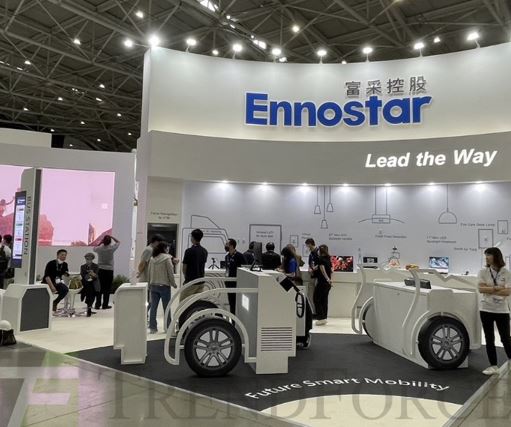
To achieve the ultimate goal of “Be Simple, Be Popularized”, Epistar is committed to assisting its partners to solve key issues of Micro LED applications, making the technology simpler and more accessible, with exhibits including 6-inch Chip on Wafer (COW) and 8-inch GaN on Silicon products. In addition, Epistar proposed multiple solutions such as COC and PAM products in different sizes with an effort to overcome mass transfer challenges, reduce difficulties and the threshold for customers to enter the Micro LED display market, and lead the industry to discover more opportunities for Micro LED. PAM stands for pitch adjustment module, enabling array transfer services for different pixel pitch settings.

Unikorn focused on Micro LED display OEM services and debuted a 0.12-inch blue Micro LED microdisplay jointly developed with Epistar and Foxconn for AR applications. This microdisplay—powered by 3µm Micro LEDs combined with a unique reflective bank technology—boasts a brightness of 200,000 nits and 6,500ppi density.
Artilux and Ennostar showcased their SWIR solutions for consumer TWS earphones and smart watches. Based on Ennostar’s SWIR LEDs and InGaAs photodiodes, Artilux incorporated analog front-end (AFE) and digital functions into a single chip using proprietary technologies to create a lightweight, cost-effective, and ultra-wide spectrum optical sensor solution. The solution also features music activated switch, skin moisture / oil detection, heart rate detection, and calorie / BMR measurement.
Artilux has been actively shipping product samples to branded manufacturers.
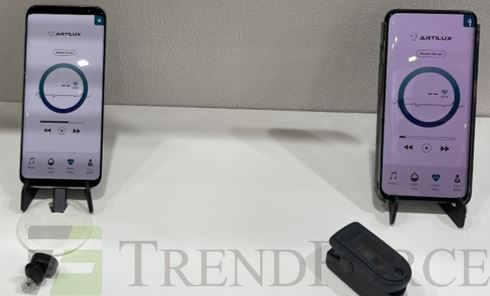
PlayNitride
PlayNitride showcased Micro LED products in three major sectors, namely video walls / TVs, AR headsets, and watches and transparent displays, bringing a brand new immersive experience through an art exhibition. The exhibitor presented the 0.49-inch Micro LED display module by showcasing a pair of AR glasses boasting over 150,000 nits of brightness, 4,536ppi of pixel density and combined optical designs, fully demonstrating the advantages of Micro LED in being thin, high resolution, and high brightness. The product has been shipped as samples to branded customers. In addition, Eight 1.39-inch watches were exhibited on site, offering RGB LED and blue LED / QD color conversion as two options. Thirdly, the 9.38-inch display comes with a >65% transparent touchscreen with brightness reaching up to 3,000 nits.

AUO
As Samsung Electronics strives for the development of AM Micro LED The Wall, LTPS supplier AUO showcased its 108-inch P0.625 Micro LED TV / Video Wall. The product has three major features. First, AUO’s A.R.T (Advanced Reflectionless Technology) features a unique surface structure that can reduce direct glare even in an environment with high light intensity, thereby ensuring excellent image quality. Guaranteeing realistic tone reproduction plus desirable saturation and contrast, the surface design also helps reduce ambient light interference; the pure black display is as good as that of OLED. Additionally, the video wall has as 2,000 nits of brightness, demonstrating its combability with high-brightness environments. Third, the multi-LTPS design enables display tiling for the desired size, demonstrating the product’s unlimited possible applications. Moreover, the displayed red and green colors on-site have high uniformity. With increasing product stability, AM Micro LED displays will thrive in the ≤P1.0 ultra fine pitch display markets.
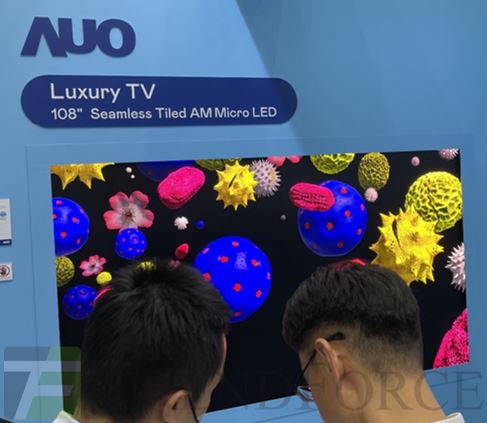
AUO launched a 1.39-inch Micro LED watch with a circular design and a pixel density of 326 ppi. It maintains color saturation and high contrast while improves color deviation at high angle and extend lifespan during display at high-brightness settings, meeting the demand for displaying clear information outdoors in bright sunlight. Their information presentation capability makes transparent displays an ideal choice for window displays in smart retail stores and vehicles (cars, metros, ships, etc.). AUO has launched its Micro LED transparent displays onto the market. This year, the manufacturer unveiled a 60" transparent display targeting at retail stores and vehicles. In addition, its applications include head-up displays and automotive displays intended for future smart vehicles featuring advanced driver assistance systems (ADAS), autonomous vehicles, and car sharing, starting a trend for mobility–communication combination.
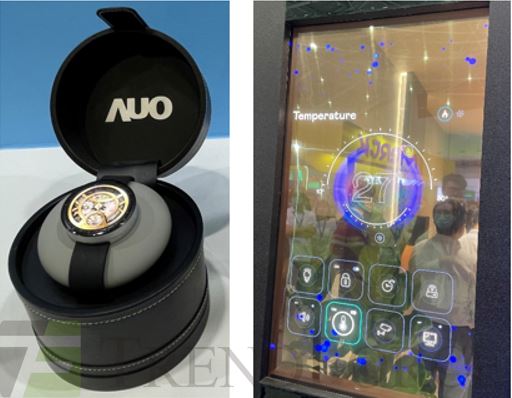
Concerning drivers’ demand, AUO has incorporated Micro LED- known for high brightness, high contrast, wide gamut, and short response time- with integrated solutions for smart in-cabin displays featuring free, curved, and flexible form as well as haptic feedback, aiming to comprehensively upgrade driver experience.
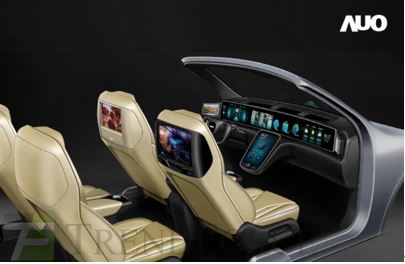
Innolux
Innolux exhibited ultra-fine pitch (P0.6) displays/TVs seamlessly tiled using Micro LED color conversion; the exceptionally fine image quality makes them the optimal solution for digital art showcases. In addition, Innolux unveiled a 1.1" Micro LED watch featuring a whopping 338 ppi density, high resolution, and low power consumption. The device delivers excellent performance with high visibility under bright sunlight and vivid color reproduction indoor, providing users a refreshing high resolution and delicate visual experience.
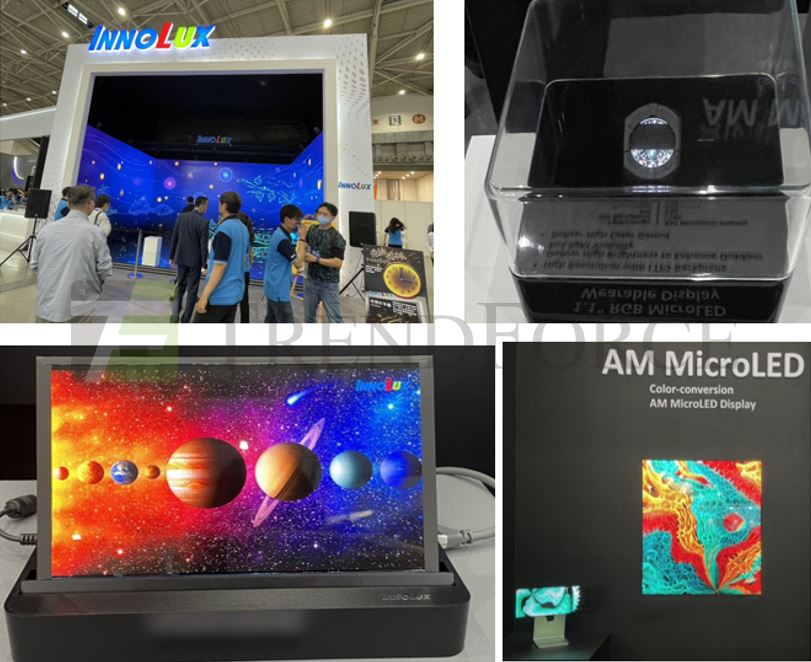
Kulicke & Soffa
Kulicke& Soffa (K&S) shared their Micro/Mini LED mass transfer system LUMINEX, whereby lasers penetrate the transparent substrate through punching and excite the dynamic release layer (between the glass carrier and Micro LEDs), causing it to rapidly gasify and form bubbles on the reaction layer. Next, the Micro/Mini LED chips are transferred to the target DCM (a material on the target substrate). According to the desired LED chip size, tape material, and pixel pitch setting, the LUMINEX is able adjust its transfer rate (UPH), for example, with an accuracy of 10μm @3σ under 100Hz. Notably, if the expanded laser reactor film is bigger than the LED in question, the neighboring LED might be affected and even fall off. Therefore, reactor film design is crucial for laser transfer. Currently, the company’s film technology has matured and proved to work in Micro/Mini LED transfer.
Compared to laser transfer, stamp transfer is more time-consuming and costly due to the requirement of PDMS molding. Moreover, the LUMINEX features flexible selection of the transfer target as per the demanded known good die (KGD) level. The system, unlike other laser transfer equipment, is compatible with various sizes and pixel pitch settings with no additional photomask cost.

ASMPT
To meet the Micro LED market demand, ASMPT rolled out the laser transfer equipment LT300Pro and bonding equipment AD300Pro, of which the UPH differs depending on the chip size, bonder size, and tape materials as requested by clients.
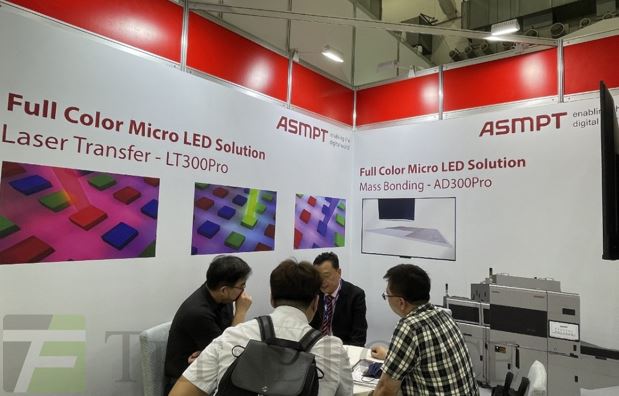
Shin-Etsu Chemical
By leveraging resources from the associate Shin-Etsu Engineering, Shin-Etsu Chemical rolled out excimer laser lift-off, laser transfer, and laser repair and trimming equipment, all of which allegedly boast a high UPH without causing damage to chips. The said transfer instrument is compatible with small-sized chips with accuracy of approx. ±3μm. The actual UPH, however, may vary depending on the chip size, bonder size, and materials as requested by clients.

Coherent
Coherent rolled out the three-in-one UVtransfer, a Micro LED laser processing system capable of laser lift-off, laser transfer, and laser repair. The equipment comes with a high-energy 248nm DUV excimer surface light source for large-area transfer, offering high UPH for customers. The system aligns dies on a carrier through high-precision coaxial vision and accurately transfers them to the desired positions on the target substrate, thereby ensuring Micro LED transfer with high precision.

Stroke PAE
Stroke PAE debuted its laser bonder, Model no. NCB-series, at the Touch Taiwan 2023 exhibition. Unlike the previous approach requiring a carrier to perform repair, the NCB-series combines several functions such as Laser debonding, solder paste dispensing, and laser repair to more effectively repair dead pixels on Micro/Mini LEDs.
-
Mini LED: The equipment is compatible with various Mini LED sizes with an accuracy of ±10μm. The time for single-chip repair (Debonding + Repair) is about 10s.
-
Micro LED: The equipment is compatible with diodes measuring <15x30μm at minimum with an accuracy of ±3μm, with the time for single-chip repair (Debonding + Repair) being 12s.
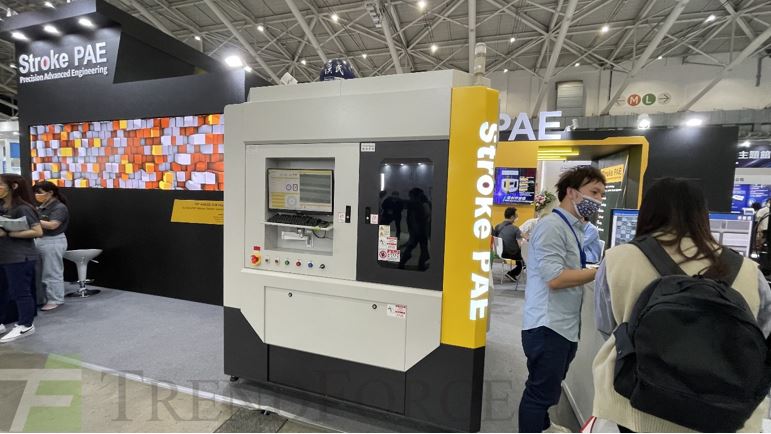
Sitan
Sitan showcased its 0.18-inch Micro LED single-screen full-color module made by bonding Micro LED chips with CMOS. Engineered with quantum-dot color conversion, the module is capable of full-color display with maximum brightness of 100,000 nits and pixel density of 3,500 ppi.
The single-screen full-color Micro LED display module, combined with array waveguide, breaks the limitation of monochrome display in AR glasses. The field of view (FOV) has been enhanced about 45%, with the perceived brightness being 600 nits. The display brightness of the full-color Micro LED AR glasses equipped with the module can reach up to 100,000 nits. The exhibited glasses are similar to their monochrome counterparts regarding size, power consumption level, and weight, providing users with more comfortable wearing and visual experiences.
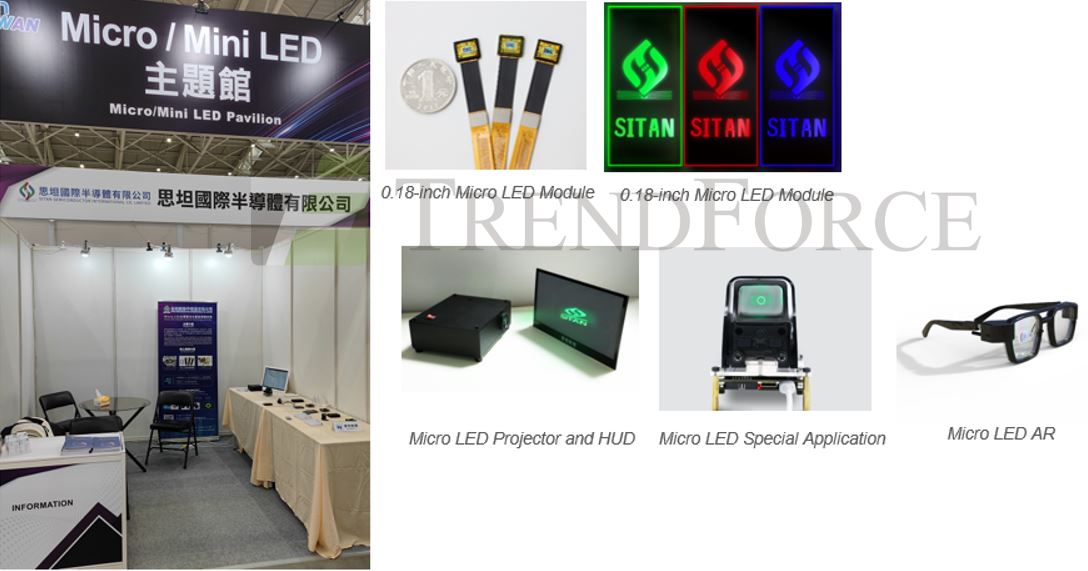
Macroblock
In response to the booming global electric vehicles/intelligent cockpits markets, Macroblock has leveraged its mature technology from the existing product lines, looking to the future of electric vehicles and intelligent cockpits.
Adaptive Driving Beam (ADB): The presented MBI6353Q has 48 channels and supports 4-scan design. With 100mA maximum current and 24V voltage, the product is able to increase brightness by driving multiple LEDs in one cascade. It can also drive the channels in parallel to boost the drive current. Its features such as multi-pixel, high current, and high brightness meet the requirements of various headlight designs.
Full-Width/Mini LED Rear Light: The full-width rear light is designed to modify conventional rear lights or center third brake lights into a strip or narrow shape. With increased light-emitting area to achieve visual extension, the rear light can be more easily recognized after being lit at night. The MBI5353Q-equipped LED display module presented on site can be used for Mini LED lighting. When the vehicle is stationary, the lighting system also turns from an illuminator into a display functioning to transmit vehicle-related information such as charging status.
Mini LED/HDR Automotive Display: a display is mounted on a steering wheel to provide driving information for the driver. Its backlight module is engineered with Macroblock’s driver IC MBI5353Q. The product features 16-bit grayscale and high contrast brought by local dimming, providing images with fine details to small-size displays; only one MBI5353Q driver IC is required to control up to 1,536 local dimming zones.
The exhibited Curved FALD (full-array local dimming) Backlight Module for a Center Information Display is equipped with the MBI6353Q as a built-in component. Notably, the novel Hybrid Mode helps improve performance in low grayscale scenarios, enabling the display to present clear information even in dim light.

Author: Joanne / TrendForce
TrendForce 2022 Micro LED Self-Emissive Display Trends and Analysis on Supplier's Strategies
Release date: 31 May 2022 / 30 November 2022
Format: PDF
Languages: Tradional Chinese / English
Pages : 130–150 in total (subject to change)
TrendForce 2022 Mini LED New Backlight Display Trend Analysis
Publication Dates: April 30 and October 31, 2022
Language: Traditional Chinese/English
Format: PDF
Number of Pages: The two publications will total 120–130 pages
TrendForce 2023 Global LED Video Wall Market Outlook and Price Cost Analysis
Release Date: 28 September 2022
Language: Traditional Chinese / English
Format: PDF
Page: 238
TrendForce 2022 Global Automotive LED Product Trend and Regional Market Analysis
Release Date:
1. PDF(123 Pages)- 30 June 2022
2. EXCEL- 30 June 2022 and 31 December 2022
Languages: Traditional Chinese / English
TrendForce 2023 Infrared Sensing Application Market and Branding Strategies
Release: 01 January 2023
Format: PDF
Language: Traditional Chinese / English
Page: 164
 Gold+ Member Report
Gold+ Member Report
|
Content
|
Publication
|
|
and Supply Database
|
PDF / Excel
|
2023-2027 Demand Market Forecast
|
|
Supply Market Analysis:
|
|
2. WW New GaN LED and As/P LED MOCVD Chamber Installations / WW Accumulated GaN LED and As/
3. GaN LED and As/P LED Wafer Market Demand
4. GaN LED and As/P LED Wafer Market Demand and Supply Analysis
|
|
and Capacity
|
PDF / Excel
|
Top 10 LED Chip Manufacturers by Revenue and
LED Package Market Analysis:
|
|
Top 10 LED Package Providers by Revenues in Backlight and Flash LED, Lighting, Automotive, Video Wall, UV LED
|
|
Price Survey- Sapphire / Chip / Package (Backlight, General Lighting, Agricultural Lighting, Automotive, Video Wall, UV LED, IR LED, VCSEL)
|
1Q (Mid Mar)
2Q (Early Jun)
3Q (Early Sep)
4Q (Early Dec)
|
|
Quarterly Update
|
PDF
|
EU / U.S- Lumileds, ams OSRAM, Cree LED
JP- Nichia, Citizen, Stanley, ROHM
|
|
ML- Dominant
|
|
CN- San’an, Changelight, HC SemiTek, Aucksun, Focus Lightings, Nationstar, Hongli, Refond, Jufei, MTC, MLS
|
|
Exhibit Report
|
PDF
|
<20 Pages
|
|
If you would like to know more details , please contact:
|
|
|
|
|





 CN
TW
EN
CN
TW
EN





